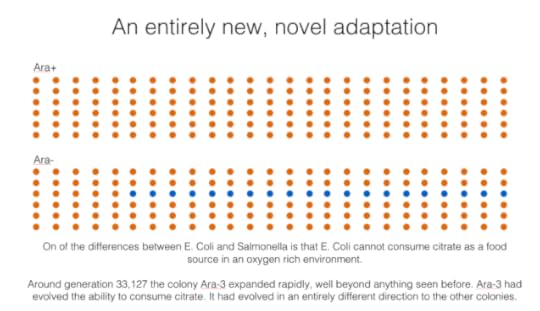Evolution in the lab
When it comes to experiments, Archimedes’ bathtub, Galileo’s rolling ball and Newton’s prism are legendary. They’re insightful and represent turning points in our collective understanding of the world around us.
In the centuries to come, Richard Lenski’s E. Coli experiment will be ranked alongside them and others, like the Michelson-Morley measurement of the speed of light, as some of the greatest experiments ever undertaken, but with one distinct difference. In the centuries to come, Lenski’s E. Coli experiment will STILL be running.
In 1988, Richard Lenski began a controlled experiment to observe evolution under laboratory conditions. Lenski chose E. Coli bacteria for the experiment as it only reproduces asexually. This ensures the genes of the offspring are identical to those of a single parent.

Picture credit: Richard Lenski
By isolating thousands of generations of E. Coli from outside influence, Lenski sought to observe evolution by means of natural genetic variation as a result of errors in replication or from naturally occurring radiation, etc, with only those variations that were favorable being naturally selected for subsequent generations. Genetic variations could only spread by common descent if they were beneficial to the bacteria.
Here’s an overview of the results of Lenski’s experiment so far…

A repeatable, isolated environment eliminated any “noise”
Creationists often cling to the fact that there are gaps in the fossil record, the so-called “missing links,” to create doubts about evolution. However, given how difficult it is for fossils to form it would be more of a surprise if there weren’t gaps.
Gaps are not an issue. They’re only an issue when people don’t understand that species are dynamic, not fixed. Lenski’s experiment demonstrated the smooth, gradual change that is missing from the fossil record only because rocks are not as effective a scientific instrument as a petri dish.

Living fossils
Lenski preserved frozen samples at regular intervals for examination at a later point in time, effectively forming a living fossil record of this species as it evolved in his laboratory.
We categorize organisms as species, but species are transitory. Most “species,” as we note them, only exist in the same state for roughly a million years or so. Animals and plants are in a constant state of flux. Their genes are malleable and plastic, although changes occur at a glacial pace.
Rather than thinking of species we should think in terms of the genetic lines that branch into various species. Again, Lenski’s experiment demonstrated how organisms diverge from a common point.

Life natural adapts to exploit opportunity
Natural selection was observed under controlled laboratory conditions. All twelve strains were completely isolated from each other and yet they all evolved to exploit their new conditions of life in roughly the same manner.

Growth in cell size of E. Coli. Picture credit: Wikimedia
E. Coli adapted to suit its new environment without any external influence. Some E. Coli lines changed more than others, but none of them remained the same, and that again makes the point that species are dynamic, not static.

Natural Selection is like the Olympics
Life seeks maximum efficiency.
Have you ever noticed how world records continue to be broken in sports? The reason is simple, competition ensures increasing effectiveness. In the same way, evolution is the setting of new records in the natural world as species continue to adapt to exploit an ecological niche against all comers.

We’re witnessing the birth of a new species
Much to the surprise and delight of scientists, Lenski’s experiment led to an entirely new, novel adaptation, the ability for E. Coli to consume citrate in an oxygen rich environment. On the surface, that may not seem that spectacular, but what Lenski witnessed at this point was the birth of a new species of bacteria. Technically, the bacteria are still E. Coli, but remember the term species is an artificial designation we assign to organisms somewhat arbitrarily.
When it comes to the slow, gradual progression of species as they branch out from a common point, there’s no clear cut delineation. Just as there’s no one particular moment when a child becomes an adult, species progress by gradual steps. In Lenski’s laboratory, the E. Coli line Ara-3 branched in a new genetic direction, forming the basis for a new species!

Be kind, rewind
Creationists are unduly hung up on the fact that we don’t see species diverging before our eyes, but that’s because it takes vast stretches of time to occur. In reality, the fact we have artificially selected wolves to become Chihuahuas and Great Danes over a few thousand years should be evidence enough. But here, Lenski has demonstrated such evolutionary change in a laboratory.
If we could replay the evolution of hominids from Homo ergaster through to Homo sapiens, there would be no huge jumps, no sudden changes in skull size or spinal column, just a slow, steady progression as smooth as the changes Lenski observed with E. Coli. At various points in time, subtle changes would be introduced and, if favorable, preserved by Natural Selection.

Picture credit: Wikimedia
Richard Lenski’s experiment confirmed what scientists had known from all the other lines of evidence, that evolution occurs naturally all the time.
An exciting aspect of Lenski’s experiment is that there’s no need for it to stop. I can’t see any reason why his experiment would not be running in a hundred or a thousand years time. How much change will occur? What will the new, emergent, divergent species look like? It’s hard to say. Lenski’s E. Coli are severely restrained and limited by their strictly controlled environment, but that hasn’t stopped evolution so far!
If anyone has any doubts about evolution, Lenski’s experiment should lay them to rest as he has shown evolution is a demonstrable fact under controlled, laboratory conditions.





